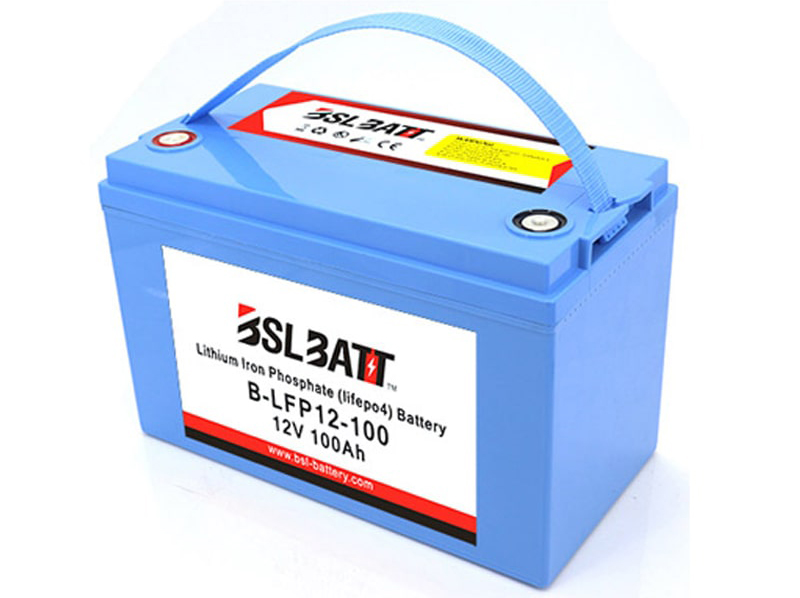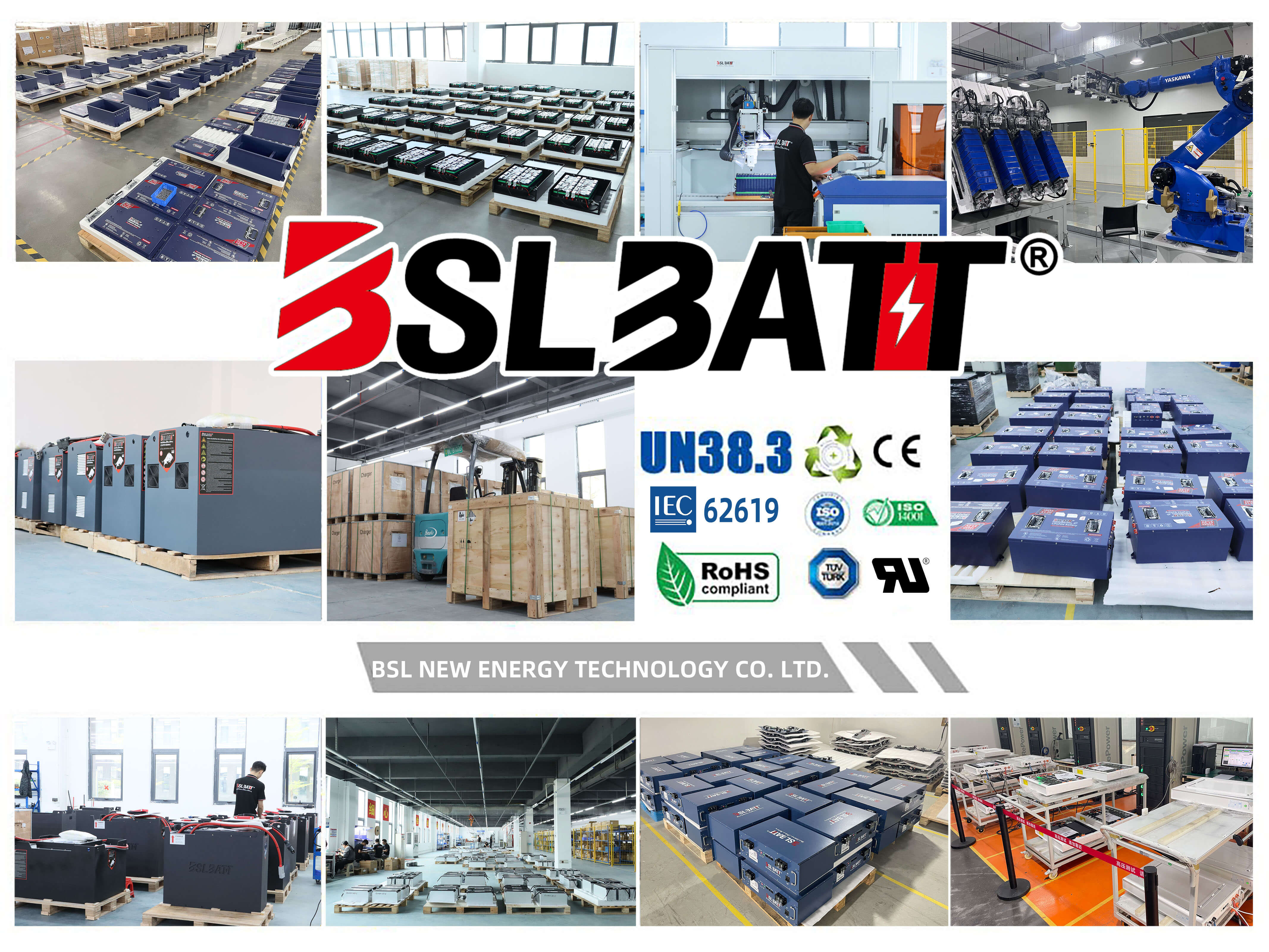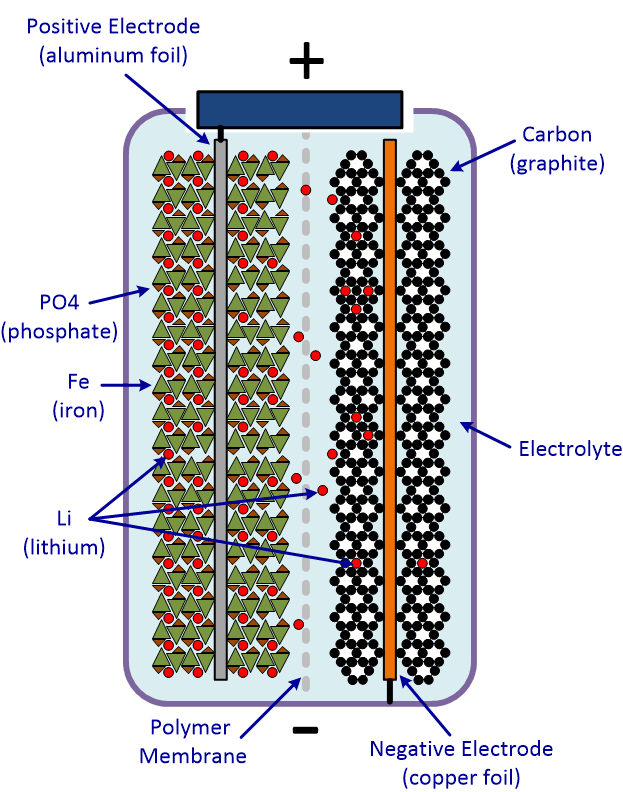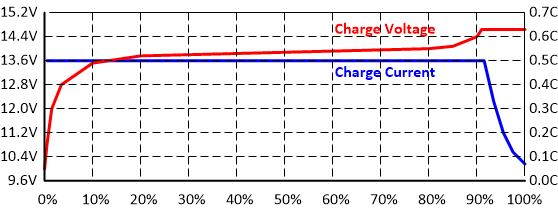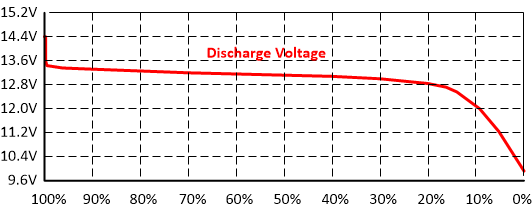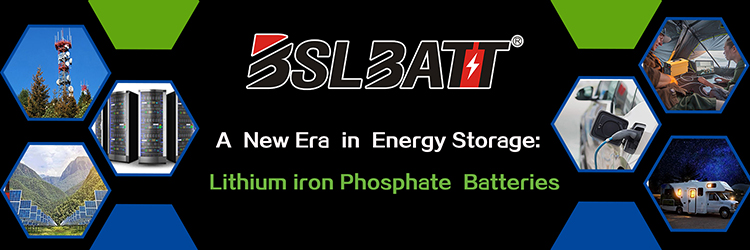Industry Application
Product Type
How to Find Happiness With LiFePO4 (Lithium-Ion) Batteries
| Now you want to know how to take care of your precious new purchase: How to best charge lithium-iron batteries, how to discharge them, and how to get the maximum life out of your lithium-ion batteries. This article will explain the do’s and don’ts.
Pricing of lithium-ion batteries is slowly changing from obscenely expensive to only moderately unaffordable, and we at BSLBATT are seeing a steady increase in sales of this type of battery. Most users seem to put them to work in RVs, fifth-wheels, campers and similar vehicles, while some are going into actual stationary off-grid systems. This article will talk about one specific category of lithium-ion batteries; Lithium-Iron-Phosphate or LiFePO4 in its chemical formula, also abbreviated as LFP batteries. These are a little different from what you have in your cell phone and laptop, those are (mostly) lithium-cobalt batteries. The advantage of LFP is that it is much more stable, and not prone to self-combustion. That does not mean the battery cannot combust in case of damage: There is a whole lot of energy stored in a charged battery and in case of an unplanned discharge the results can get very interesting very quickly! LFP also lasts longer in comparison to lithium-cobalt, and is more temperature-stable. Of all the various lithium battery technologies out there this makes LFP best suited for deep-cycle applications! We will assume the battery has a BMS or Battery Management System, as almost all LFP batteries that are sold as a 12/24/48 Volt pack do. The BMS takes care of protecting the battery; it disconnects the battery when it is discharged, or threatens to be over-charged. The BMS also takes care of limiting the charge and discharge currents, monitors cell temperature (and curtails charge/discharge if needed), and most will balance the cells each time a full charge is done (think of balancing as bringing all the cells inside the battery pack to the same state-of-charge, similar to equalizing for a lead-acid battery). Unless you like living on the edge, DO NOT BUY a battery without BMS! What follows below is the knowledge gleaned from reading a large number of Web articles, blog pages, scientific publications, and discussion with LFP manufacturers. Be careful what you believe, there is a lot of misinformation out there! While what we write here is by no means meant as the ultimate guide to LFP batteries, our hope is that this article cuts through the bovine excrement and gives solid guidelines to get the most out of your lithium-ion batteries.
Why Lithium-Ion?We explained in our lead-acid battery article how the Achilles heel of that chemistry is sitting at a partial charge for too long. It is too easy to pooch an expensive lead-acid battery bank in mere months by letting it sit at a partial charge. That is very different for LFP! You can let lithium-ion batteries sit at a partial charge forever without damage. In fact, LFP prefers to sit at a partial charge rather than being completely full or empty, and for longevity, it is better to cycle the battery or to let it sit at a partial charge. But wait! There is more! Lithium-ion batteries are very nearly the holy grail of batteries: With the right charge parameters, you can almost forget there is a battery. There is no maintenance. The BMS will take care of it, and you can happily cycle away! But wait! There is still more! (Any resemblance with certain infomercials is purely coincidental, and, frankly, we resent the suggestion!)… LFP batteries can also last a very long time. Our BSLBATT LFP batteries are rated at 3000 cycles, at a full 100% charge/discharge cycle. If you did that every day it makes for over 8 years of cycling! They last even longer when used in less-than-100% cycles, in fact for simplicity you can use a linear relationship: 50% discharge cycles means twice the cycles, 33% discharge cycles and you can reasonably expect three times the cycles. But wait! There is more yet!… A LiFePO4 battery also weighs less than 1/2 of a lead-acid battery of similar capacity. It can handle large charge currents (100% of Ah rating is no problem, try that with lead-acid!), allowing for rapid charging, it is sealed so there are no fumes, and it has a very low self-discharge rate (3% a month or less). Battery Bank Sizing for LFPWe hinted at this above: Lithium-ion batteries have 100% usable capacity, while lead-acid really ends at 80%. That means you can size an LFP battery bank smaller than a lead-acid bank, and still have it be functionally the same. The numbers suggest that LFP can be 80% the Amp-hour size of lead-acid. There is more to this though. For longevity lead-acid battery banks should not be sized where they regularly see discharging below 50% SOC. With LFP that is no problem! Round-trip energy efficiency for LFP is quite a bit better than lead-acid as well, meaning that less energy is needed to fill up the tank after a certain level of discharge. That results in faster recovery back to 100%, while we already had a smaller battery bank, reinforcing this effect even more. The bottom line is that we would be comfortable to size a lithium-ion battery bank at 75% of the size of an equivalent lead-acid bank, and expect the same (or better!) performance. Including on those dark winter days when sun is in short supply.
But Wait a Minute!Is lithium-ion really the solution to all our battery woos? Well, not quite… LFP batteries too have their limitations. A big one is a temperature: You cannot charge a lithium-ion battery below freezing, or zero Centigrade. Lead-acid could not care less about this. You can still discharge the battery (at a temporary capacity loss), but charging is not going to happen. The BMS should take care to block charging at freezing temperatures, avoiding accidental damage. Temperature is also an issue at the high end. The biggest single cause of aging of the batteries is use or even just storage at high temperatures. Up to around 30 Centigrade, there is no problem. Even 45 Centigrade does not incur too much of a penalty. Anything higher really accelerates aging and ultimately the end of the battery though. This includes storing the battery when it is not being cycled. We will talk about this in more detail later when discussing how LFP batteries fail. There is a sneaky issue that can crop up when using charging sources that potentially provide a high Voltage: When the battery is full the Voltage will rise unless the charging source stops charging. If it rises enough the BMS will protect the battery and disconnect it, leaving that charging source to rise even more! This can be an issue with (bad) car alternator Voltage regulators, that need to always see a load or the Voltage will spike and the diodes will release their magic smoke. This can also be an issue with small wind turbines that rely on the battery to keep them under control. They can run away when the battery disappears. Then there is that steep, steep, initial purchase price! But we bet you still want one!… How Does a LiFePO4 Battery Work?
Discharging the battery does the same thing in reverse: As electrons flow away through the negative electrode, the lithium ions once again go on the move, through the membrane, back to the iron-phosphate lattice. They are once again stored on the positive side until the battery gets charged again. If you have really been paying attention you now understand that the battery drawing on the right shows an LFP battery that is almost completely discharged. Nearly all the lithium ions are on the side of the positive electrode. A fully charged battery would have those lithium ions all stored inside the carbon of the negative electrode. In the real world, lithium-ion cells are built of very thin layers of alternating aluminum – polymer – copper foils, with the chemicals pasted on them. Often they are rolled up like a jelly-roll, and put in a steel canister, much like an AA battery. The 12 Volt lithium-ion batteries you buy are made of many of those cells, connected in series & parallel to increase the Voltage and Amp-hour capacity. Each cell is around 3.3 Volt, so 4 of them in series make 13.2 Volt. That is just the right Voltage for replacing a 12 Volt lead-acid battery! Charging an LFP BatteryMost regular solar charge controllers have no trouble charging lithium-ion batteries. The Voltages needed are very similar to those used for AGM batteries (a type of sealed lead-acid battery). The BMS helps too, in making sure the battery cells see the right Voltage, do not get overcharged, or overly-discharged, it balances the cells and ensures the cell temperature is within reason while they are being charged. The graph below shows a typical profile of a LiFePO4 battery getting charged. To make it easier to read the Voltages have been converted to what a 12 Volt LFP battery pack would see (4x the single-cell Voltage).
Shown in the graph is a charge rate of 0.5C, or half of the Ah capacity, in other words for a 100Ah battery this would be a charge rate of 50 Amp. The charge Voltage (in red) will not really change much for higher or lower charge rates (in blue), LFP batteries have a very flat Voltage curve. Lithium-ion batteries are charged in two stages: First, the current is kept constant, or with solar PV that generally means that we try and send as much current into the batteries as available from the sun. The Voltage will slowly rise during this time, until it reaches the ‘absorb’ Voltage, 14.6V in the graph above. Once absorb is reached the battery is about 90% full, and to fill in the rest of the way the Voltage is kept constant while the current slowly tapers off. Once the current drops to around 5% – 10% of the Ah rating of the battery it is at 100% State-Of-Charge. In many ways a lithium-ion battery is easier to charge than a lead-acid battery: As long as the charge Voltage is high enough to move ions it charges. Lithium-ion batteries do not care if they are not fully 100% charged, in fact, they last longer if they are not. There is no sulfating there is no equalizing, the absorb time does not really matter, you cannot really overcharge the battery, and the BMS takes care of keeping things within reasonable boundaries. So what Voltage is enough to get those ions moving? A little experimenting shows that 13.6 Volt (3.4V per cell) is the cut-off point; below that very little happens, while above that the battery will get at least 95% full given enough time. At 14.0 Volt (3.5V per cell) the battery easily charges up to 95+ percent with a few hours absorb time and for all intents and purposes there is little difference in charging between 14.0 or higher Voltages, things just happen a little faster at 14.2 Volt and above. Bulk/Absorb Voltage To summarize this, a bulk/absorb setting between 14.2 and 14.6 Volt will work great for LiFePO4! Lower is possible too, down to about 14.0 Volt, with the help of some absorb time. Slightly higher Voltages are possible, the BMS for most batteries will allow around 14.8 – 15.0 Volt before disconnecting the battery. There is no benefit to a higher Voltage though, and more risk of getting cut of by the BMS, and possibly damage. Float Voltage LFP batteries do not need to be floated. Charge controllers have this because lead-acid batteries have such a high rate of self-discharge that it makes sense to keep trickling in more charge to keep them happy. For lithium-ion batteries, it is not great if the battery constantly sits at a high State-Of-Charge, so if your charge controller cannot disable float, just set it to a low enough Voltage that no actual charging will happen. Any Voltage of 13.6 Volt or less will do. Equalize Voltage With charge Voltages over 14.6 Volt actively discouraged, it should be clear that no equalize should be done to a lithium-ion battery! If equalize cannot be disabled, set it to 14.6V or less, so it becomes just a regular absorb charge cycle. Absorb Time There is a lot to be said for simply setting the absorb voltage to 14.4V or 14.6V, and then just stop charging once the battery reaches that Voltage! In short, zero (or a short) absorb time. At that point, your battery will be around 90% full. LiFePO4 batteries will be happier in the long run when they do not sit at 100% SOC for too long, so this practice will extend battery life. If you absolutely have to have 100% SOC in your battery then absorb will do that! Officially this is reached when the charge current drops to 5% – 10% of the Ah rating of the battery, so 5 – 10 Amp for a 100Ah battery. If you cannot stop absorb based on current, then set absorb the time to about 2 hours and call it a day. Temperature Compensation LiFePO4 batteries do not need temperature compensation! Please switch this off in your charge controller, or your charge Voltage will be wildly off when it is very warm or cold. Be sure to check your charge controller Voltage settings against those actually measured with a good quality digital multimeter! Small changes in Voltage can have a big impact when charging a lithium-ion battery! Change the charge settings accordingly! Discharging an LFP BatteryUnlike lead-acid batteries, the voltage of a lithium-ion battery stays very constant during discharge. That makes it difficult to divine the State-Of-Charge from Voltage alone. For a battery with a moderate load, the discharge curve looks as follows.
Most of the time during discharge, the battery Voltage will be right around 13.2 Volt. It varies by just 0.2 Volt all the way from 99% to 30% SOC. Not long ago it was a Very Bad Idea™ to go below 20% SOC for a LiFePO4 battery. That has changed, and the current crop of LFP batteries will quite merrily discharge all the way down to 0% for many cycles. However, there is a benefit in cycling less deep. It is not just that cycling to 30% SOC will get you 1/3 more cycles vs. cycling down to 0%, your battery will likely live for more cycles than that. Hard numbers are, well, hard to come by, but cycling down to 50% SOC seems to show around 3x the cycle life vs. cycling 100%. Below is a table that shows battery Voltage for a 12 Volt battery pack vs. Depth-Of-Discharge. Take these Voltage values with a grain of salt, the discharge curve is so flat that it really is hard to determine SOC from Voltage alone. Small variations in load, and accuracy of the Volt meter will throw off the measurement. Storing Lithium-Ion BatteriesThe very low self-discharge rate makes it easy to store LFP batteries, even for longer periods. It is no problem to put a lithium-ion battery away for a year, just make sure there is some charge in it before placing it in storage. Something between 50% – 70% is fine, that will give the battery a very long time before self-discharge brings the Voltage close to the danger point. Storing batteries below freezing is fine, they do not freeze and do not care much about temperature. Try to avoid storing them at high temperatures (45 Centigrade and above), and try to avoid storing them completely full if possible (or nearly empty). If you need to store batteries for longer periods, be sure to simply disconnect all wires from them. That way there can not be any stray loads that slowly discharge the batteries. The End of Your Lithium-Ion BatteriesWe hear you gasp in horror; the thought of your precious LFP battery bank being no longer sends shivers down your spine! Alas, all good things eventually have to come to an end. What we want to prevent is an end of the premature kind, and to do that we have to understand how lithium-ion batteries die. Battery manufacturers consider a battery “dead” when its capacity falls to 80% of what it should be. So, for a 100Ah battery, its end comes when its capacity is down to 80Ah. There are two mechanisms at work towards the demise of your battery: Cycling and aging. Each time you discharge and recharge the battery it does a little bit of damage, and you lose a little bit of capacity. But even if you put your precious battery in a beautiful glass-enclosed shrine, never to be cycled, it will still come to an end. That last one is called calendar life. It is difficult to find hard data on calendar life for LiFePO4 batteries, very little is out there. Some scientific studies were done on the effect of extremes (in temperature, and SOC) on calendar life, and those help set limits. What we gather is that if you do not abuse your battery bank, avoid extremes, and generally just use your batteries within reasonable bounds, there is an upper limit of around 20 years on calendar life. Besides the cells inside the battery, there is also the BMS, which is made out of electronic parts. When the BMS fails, so will your battery. Lithium-ion batteries with a build-in BMS are still too new, and we will have to see, but ultimately the Battery Management System has to survive for as long as the lithium-ion cells do as well. Processes inside the battery conspire over time to coat the boundary layer between electrodes and electrolytes with chemical compounds that prevent the lithium ions from entering and leaving the electrodes. Processes also bind lithium ions into new chemical compounds, so they are no longer available to move from electrode to electrode. Those processes will happen no matter what we do, but they are very much dependent on temperature! Keep your batteries under 30 Centigrade and they are very slow. Go over 45 Centigrade and things speed up considerably! Public enemy no. 1 for lithium-ion batteries, by far, is heat! There is more to calendar life and how quickly a LiFePO4 battery will age: State-Of-Charge has something to do with it as well. While high temperatures are bad, these batteries really, really do not like to sit at 0% SOC and very high temperatures! Also bad, though not quite as bad as 0% SOC, is for them to sit at 100% SOC and high temperatures. Very low temperatures have less of an effect. As we discussed, you cannot (and the BMS will not let you) charge LFP batteries below freezing. As it turns out, discharging them below freezing, while possible, does have an accelerated effect on aging as well. Nowhere near as bad as letting your battery sit at a high temperature, but if you are going to subject your battery to freezing temperatures it is better to do so while it is neither charging nor discharging and with some gas in the tank (though not a full tank). In a more general sense, it is better to put away these batteries at around 50% – 60% SOC if they need longer-term storage. Melted batteryIf you really want to know, what happens when a lithium-ion battery gets charged below freezing is that metallic lithium is deposited on the negative (carbon) electrode. Not in a nice way either, it grows in sharp, needle-like structures, that eventually puncture the membrane and short out the battery (leading to a spectacular Rapid Unscheduled Disassembly Event as NASA calls it, involving smoke, extreme heat, and quite possibly flames as well). Lucky for us, this is something the BMS prevents from happening. We are moving on to cycle life. It has become common to get thousands of cycles, even at a full 100% charge-discharge cycle, out of lithium-ion batteries. There are some things you can do though to maximize cycle life. We talked about how lithium iron phosphate battery work: They move lithium ions between the electrodes. It is important to understand that these are actual, physical particles, that have a size to them. They are yanked out of one electrode and stuffed into the other, each time you charge-discharge the battery. This causes damage, in particular to the carbon of the negative electrode. Each time the battery gets charged the electrode swells a bit, and each discharge it slims down again. Over time that causes microscopic cracks. It is because of this that charging a little below 100% will give you more cycles, as will discharging to a little above 0%. Also, think of those ions as exerting “pressure”, and extreme State-Of-Charge numbers exert more pressure, causing chemical reactions that are not to the benefit of the battery. That is why LFP batteries do not like to be put away at 100% SOC or put into float-charging at (near) 100%. How fast those lithium ions get yanked hither and yon has an effect on cycle life as well. In light of the above, that should be no surprise. While lithium iron phosphate battery will routinely do charging and discharging at 1C (i.e. 100 Amp for a 100Ah battery), you will see more cycles out of your battery if you limit this to more reasonable values. Lead-acid batteries have a limit of around 20% of Ah rating, and staying within this for lithium-ion will have benefits for longer battery life as well. The last factor worth mentioning is Voltage, though this is really what the BMS is designed to keep in check. Lithium-ion batteries have a narrow Voltage window, for both charging and discharging. Going outside that window very quickly results in permanent damage and on the high end a possible RUD Event (NASA-talk, as mentioned before). For lithium iron phosphate battery that window is about 8.0V (2.0V per cell) to 16.8 Volt (4.2V per cell). The build-in BMS should take care to keep the battery well within those limits. Take-Home LessonsNow that we know how lithium-ion batteries work, what they like and dislike, and how they ultimately fail, there are some pointers to take away. We have made a little list below. If you are going to do nothing else, please take note of the first two, they have by far the most effect on the overall time you will get to enjoy your lithium-ion battery! Taking heed of the others will help too, to make your battery last even longer. To sum up, for long and happy LFP battery life, in order of importance, you should be mindful of the following: ● Keep the battery temperature under 45 Centigrade (under 30C if possible) – This is by far the most important!! That is it! Now you too can find happiness and fulfilling life with your LiFePO4 batteries!
|
A Guide to Choosing the Best 48V Lithium Golf Cart Battery
Would it be worth investing in a 48V ...
10 Exciting Ways To Use Your 12V Lithium Batteries
Back in 2016 when BSLBATT first began designing what would become the first drop-in replacemen...
BSLBATT Battery Company Receives Bulk Orders from North American Customers
BSLBATT®, a China Forklift battery manufacturer specializing in the material handling indust...
Fun Find Friday: BSLBATT Battery is coming to another great LogiMAT 2022
MEET US! VETTER’S EXHIBITION YEAR 2022! LogiMAT in Stuttgart: SMART – SUSTAINABLE – SAF...
Looking for new Distributors and Dealers for BSL Lithium Batteries
BSLBATT battery is a fast-paced, high-growth (200% YoY ) hi-tech company that is leading the a...
BSLBATT to Participate at MODEX 2022 on March 28-31 in Atlanta, GA
BSLBATT is one of the largest developers, manufacturers, and integrators of lithium-ion batter...
What makes the BSLBATT the Superior Lithium Battery for your Motive Power needs?
Electric forklift and Floor Cleaning Machines owners who seek the ultimate performance will fi...














